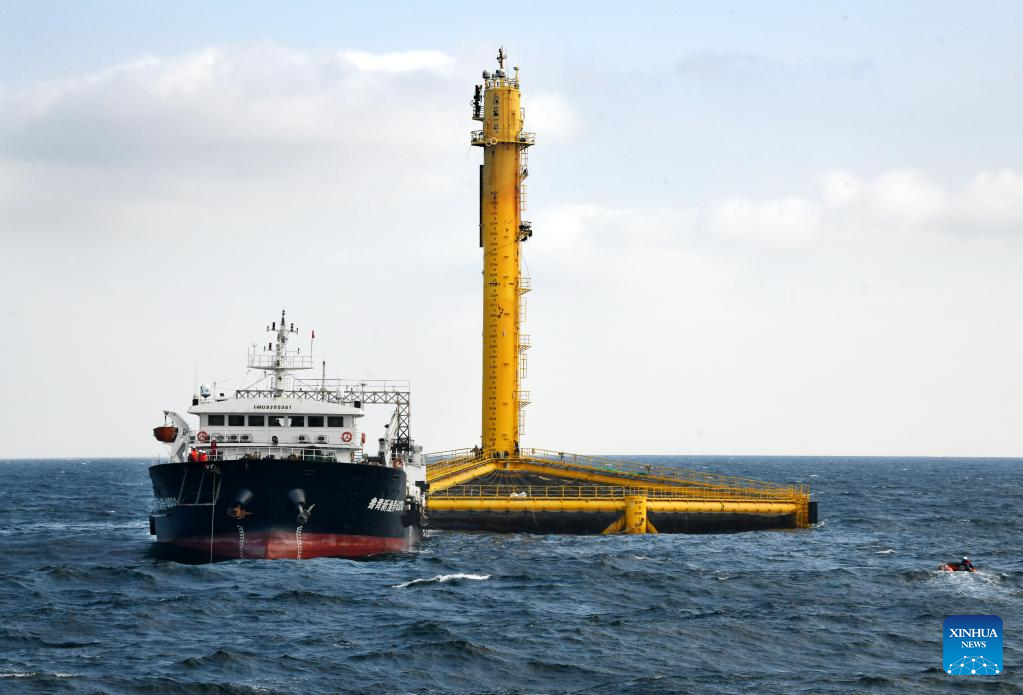
A salmon processing vessel harvests Atlantic salmons near "Deep Blue No. 1" at a fish farming experimental area of Qingdao, east China's Shandong Province, June 7, 2022. "Deep Blue No. 1," located at about 130 nautical miles from the coast of the Yellow Sea of China, is the first fully submersible deep-sea fish farming equipment built by China.
About 15,000 Atlantic salmons in the net cage of the fully submersible deep-sea fish farming equipment were fished during the period from May 22 to June 9, which marks China's first successful harvest of self-bred deep-sea Atlantic salmons.
(Xinhua/Li Ziheng)
JINAN, June 17 (Xinhua) -- About 15,000 Atlantic salmons in the net cage of a fully submersible deep-sea fish farming equipment were fished during the period from May 22 to June 9, which marks China's first successful harvest of self-bred deep-sea Atlantic salmons.
"This is China's first successful large-scale farming of Atlantic salmons in warm waters," said Guo Peng, chief agronomist of the agriculture and rural affairs department of east China's Shandong Province.
It also provides a guarantee for China's marine food security.
SUCCESSFUL HARVEST
"Deep Blue No. 1," located at about 130 nautical miles from the coast of the Yellow Sea of China, is the first fully submersible deep-sea fish farming equipment built by China.
As the harvesting began, a thick tube was inserted into the net cage of "Deep Blue No. 1," and one Atlantic salmon after another were inhaled from the sea into the vessel.
"Unlike the netting operation in a traditional fisher, this particular salmon processing vessel uses a special pump to catch the fish", said Li Hong, vice chairwoman of Shandong Far-sea Aquaculture Co., Ltd.
After preliminary processing in the vessel, workers packed the fish in long transparent bags and placed them in special insulated boxes, which were then covered with ice and sealed to ensure the temperature of the fish could be maintained between zero to four degree Celsius. The whole process takes 45 minutes, according to Li.
Experts said Atlantic salmons mainly come from near-shore sea waters of Norway, Chile and other high-latitude countries.
This time, China chose to breed the fish 30 meters below the water of the Yellow Sea, where the temperature, water quality, dissolved oxygen and other indicators are perfect for the Atlantic salmons to live.
"There are about 100,000 Atlantic salmons in the net cage, and so far, a total of 15,000 fish have been harvested," said Li, adding that the quality of those salmons meets the standards for export to the EU.
GAINING POPULARITY
"The fish carrier will arrive at the Qingdao West Coast New Area in about 10 hours, which means that local consumers could buy the fresh salmons in markets within 12 hours," said Tang Qingkai with Shandong Far-sea Aquaculture Co., Ltd.
Most of the Atlantic salmons will be transported to big cities such as Guangzhou, Beijing and Shanghai via both cold chain and airfreight, reaching the primary distributors in 36 hours at most, which can guarantee the maximum freshness of the fish.
In recent years, as Chinese people's living standards have been rising rapidly, salmon has become increasingly popular among consumers.
Consumption data from a supermarket in Beijing showed that it currently has a group of regular consumers who come to buy salmon 2 to 3 times a week. Most of them are young and middle-aged white-collar workers.
Zhou Zhenpeng, manager of a Japanese restaurant in Beijing, said they can sell nearly 60,000 platters of salmon sashimi a month.
"Our self-bred Atlantic salmon are characterized by fast maturity, high quality, less disease, low cost and good taste," said Dong Shuanglin, a professor at the Ocean University of China.
According to Wang Yanan, head of the fisheries department of Qingdao Municipal Marine Development Bureau, for a long time, China's demand for Atlantic salmon mainly relied on imports. But, due to the global pandemic, China suffers from a shortage of Atlantic salmon supply.
"The self-bred deep-sea Atlantic salmon provides a new choice of high-quality protein for consumers," said Wang. "And most importantly, this kind of large-scale, ecological and intelligent farming management also contributes to the marine food security of our country," said Wang.
EXPLORING FURTHER
As early as the middle of the 20th century, Chinese scientists put forward the idea of "farming and ranching on the sea." However, many technical problems remained unsolved at that time, therefore, for a long time, China only carried out inshore culture and fishery.
In recent years, however, as China has gradually increased its investment in marine science, a series of high and new technologies, including the "Deep Blue No.1," have been applied to explore the mariculture in the deep sea.
Looking down from the sky, "Deep Blue No.1," which weighs more than 1,500 tonnes and whose octagonal cage is the size of two football fields, is like a huge golden net in the deep blue ocean.
According to Dong Shuanglin, the design of this giant piece of equipment overcame a number of problems such as sink and float control, and shark prevention, which is a major breakthrough in China's self-design and development of deep-sea fish farming equipment.
"Salmon is a cold-water fish. When the sea surface water temperature is too high in summer, we sink the net cage to 25 meters underwater, where the water is colder. Then when the water temperature is low in winter, we raise it to the warm area again so as to ensure that the salmon can grow in suitable water temperatures all year round," said Dong.
In order to keep abreast of the digitalized collection of seawater quality and environmental parameters and the latest fish activity dynamics, "Deep Blue No.1" is equipped with a biomass monitoring system. The system enables breeders to see real-time monitoring of salmons' living conditions, feeding conditions and their shape and size in the control center, and therefore they can operate accordingly to feed them, which greatly improved the salmons' quality.
"The potential of deep-sea fisheries is huge, and so is the corresponding equipment industry. The two will move forward together," said Yang Huiyong, senior engineer of Qingdao Beihai Shipbuilding Heavy Industry Co. Ltd.
"Through 'Deep Blue No.1,' we hope to explore a new model for deep-sea mariculture in China, and also provide a Chinese solution for large-scale cold-water fish farming in the warm waters for the world," said Tang Qingkai. ■

A staff member works for harvesting Atlantic salmons at a fish farming experimental area of Qingdao, east China's Shandong Province, June 7, 2022. "Deep Blue No. 1," located at about 130 nautical miles from the coast of the Yellow Sea of China, is the first fully submersible deep-sea fish farming equipment built by China.
About 15,000 Atlantic salmons in the net cage of the fully submersible deep-sea fish farming equipment were fished during the period from May 22 to June 9, which marks China's first successful harvest of self-bred deep-sea Atlantic salmons.
(Xinhua/Li Ziheng)
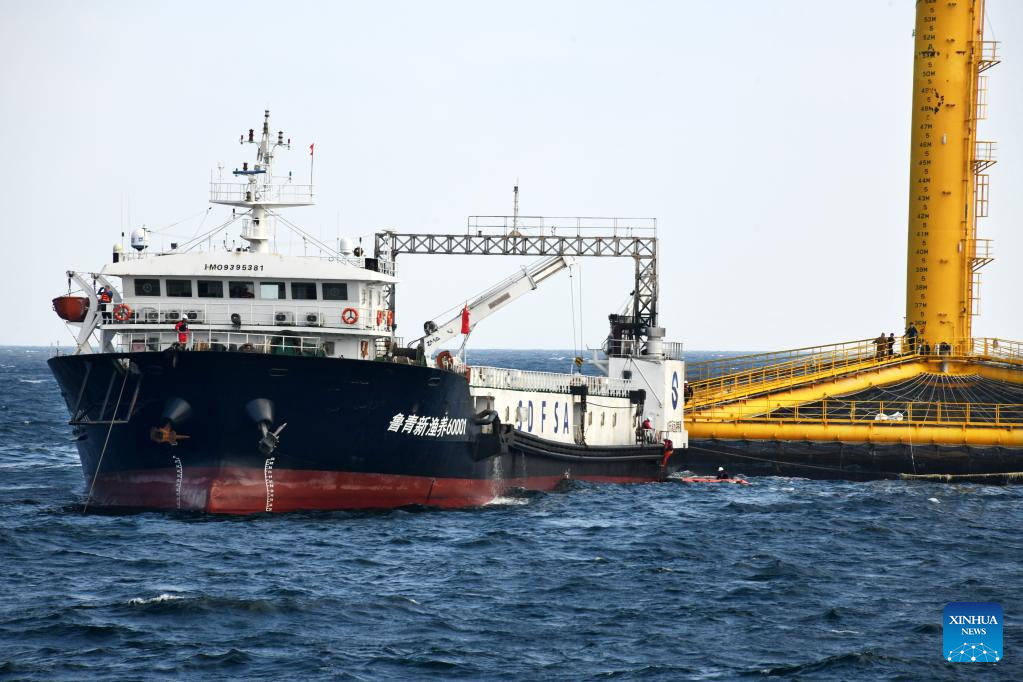
A salmon processing vessel harvests Atlantic salmons near "Deep Blue No. 1" at a fish farming experimental area of Qingdao, east China's Shandong Province, June 7, 2022. "Deep Blue No. 1," located at about 130 nautical miles from the coast of the Yellow Sea of China, is the first fully submersible deep-sea fish farming equipment built by China.
About 15,000 Atlantic salmons in the net cage of the fully submersible deep-sea fish farming equipment were fished during the period from May 22 to June 9, which marks China's first successful harvest of self-bred deep-sea Atlantic salmons.
(Xinhua/Li Ziheng)
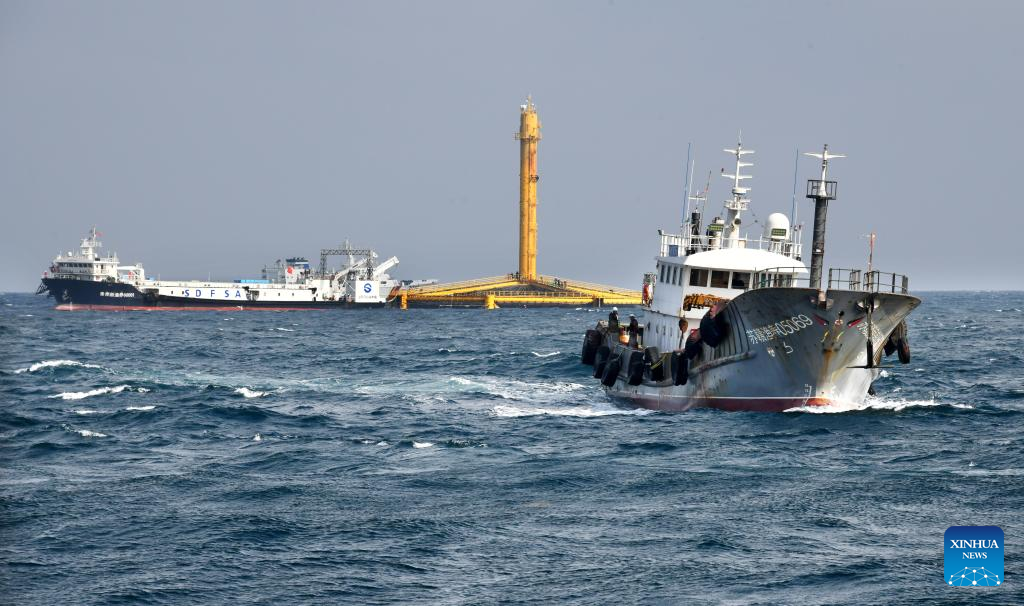
A fishing vessel (front) helps to harvest Atlantic salmons at a fish farming experimental area of Qingdao, east China's Shandong Province, June 7, 2022. "Deep Blue No. 1," located at about 130 nautical miles from the coast of the Yellow Sea of China, is the first fully submersible deep-sea fish farming equipment built by China.
About 15,000 Atlantic salmons in the net cage of the fully submersible deep-sea fish farming equipment were fished during the period from May 22 to June 9, which marks China's first successful harvest of self-bred deep-sea Atlantic salmons.
(Xinhua/Li Ziheng)
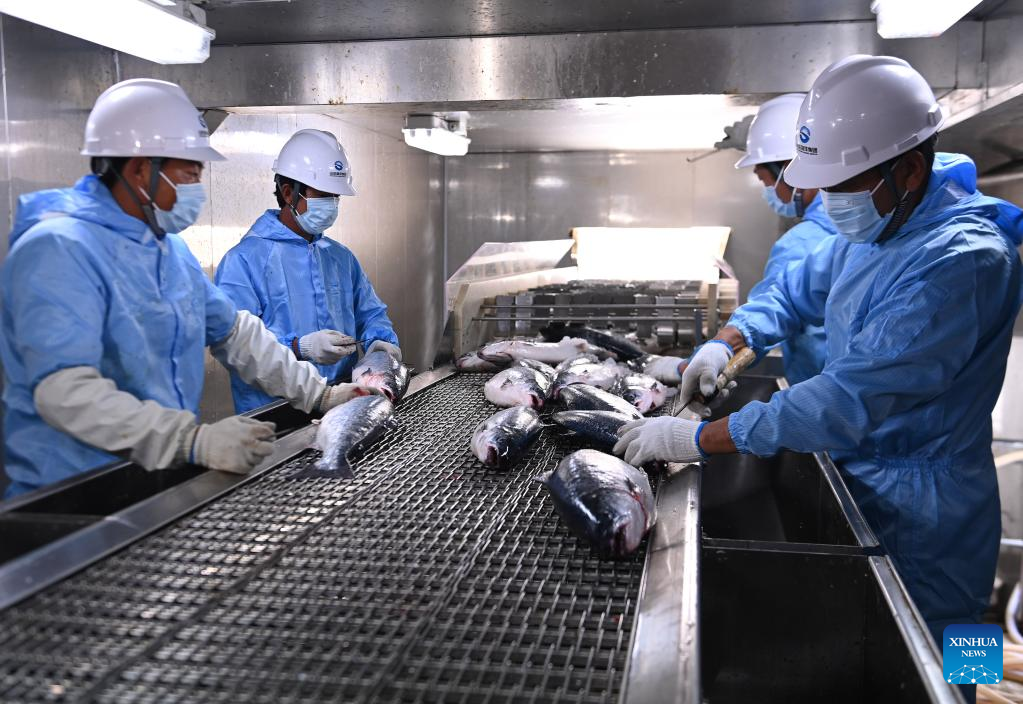
Staff members process harvested Atlantic salmons on a salmon processing vessel at a fish farming experimental area of Qingdao, east China's Shandong Province, June 8, 2022. "Deep Blue No. 1," located at about 130 nautical miles from the coast of the Yellow Sea of China, is the first fully submersible deep-sea fish farming equipment built by China.
About 15,000 Atlantic salmons in the net cage of the fully submersible deep-sea fish farming equipment were fished during the period from May 22 to June 9, which marks China's first successful harvest of self-bred deep-sea Atlantic salmons.
(Photo by Yu Fangping/Xinhua)
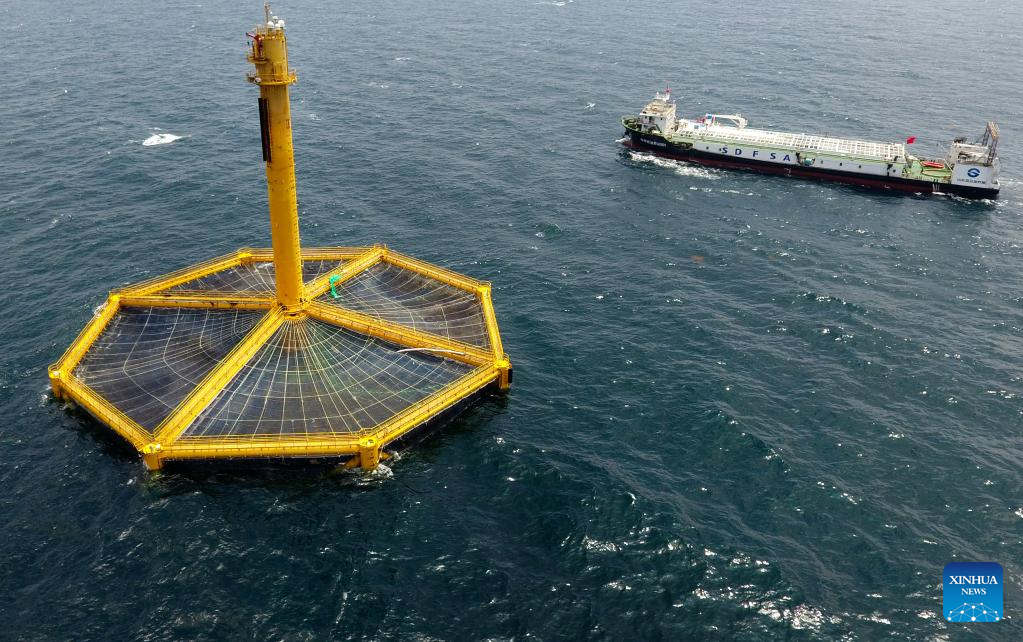
Aerial photo taken on June 7, 2022 shows a salmon processing vessel approaching "Deep Blue No. 1" to harvest Atlantic salmons at a fish farming experimental area of Qingdao, east China's Shandong Province. "Deep Blue No. 1," located at about 130 nautical miles from the coast of the Yellow Sea of China, is the first fully submersible deep-sea fish farming equipment built by China.
About 15,000 Atlantic salmons in the net cage of the fully submersible deep-sea fish farming equipment were fished during the period from May 22 to June 9, which marks China's first successful harvest of self-bred deep-sea Atlantic salmons.
(Xinhua/Li Ziheng)
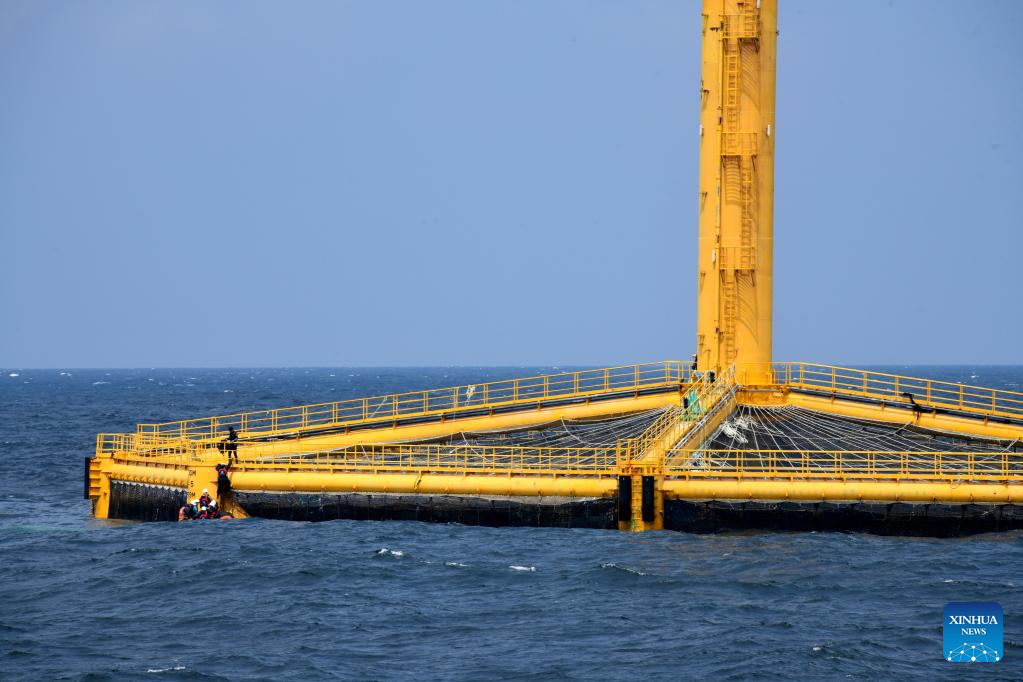
Staff members get on the "Deep Blue No. 1" to harvest Atlantic salmons at a fish farming experimental area of Qingdao, east China's Shandong Province, June 7, 2022. "Deep Blue No. 1," located at about 130 nautical miles from the coast of the Yellow Sea of China, is the first fully submersible deep-sea fish farming equipment built by China.
About 15,000 Atlantic salmons in the net cage of the fully submersible deep-sea fish farming equipment were fished during the period from May 22 to June 9, which marks China's first successful harvest of self-bred deep-sea Atlantic salmons.
(Xinhua/Li Ziheng)
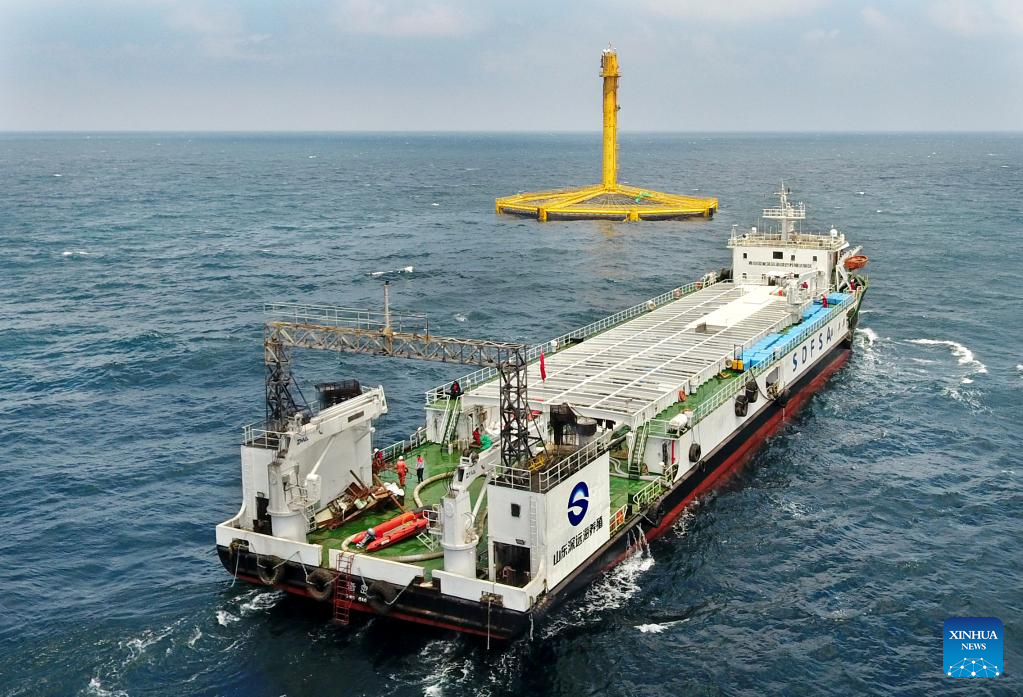
Aerial photo taken on June 7, 2022 shows a salmon processing vessel approaching "Deep Blue No. 1" at a fish farming experimental area of Qingdao, east China's Shandong Province. "Deep Blue No. 1," located at about 130 nautical miles from the coast of the Yellow Sea of China, is the first fully submersible deep-sea fish farming equipment built by China.
About 15,000 Atlantic salmons in the net cage of the fully submersible deep-sea fish farming equipment were fished during the period from May 22 to June 9, which marks China's first successful harvest of self-bred deep-sea Atlantic salmons.
(Xinhua/Li Ziheng)
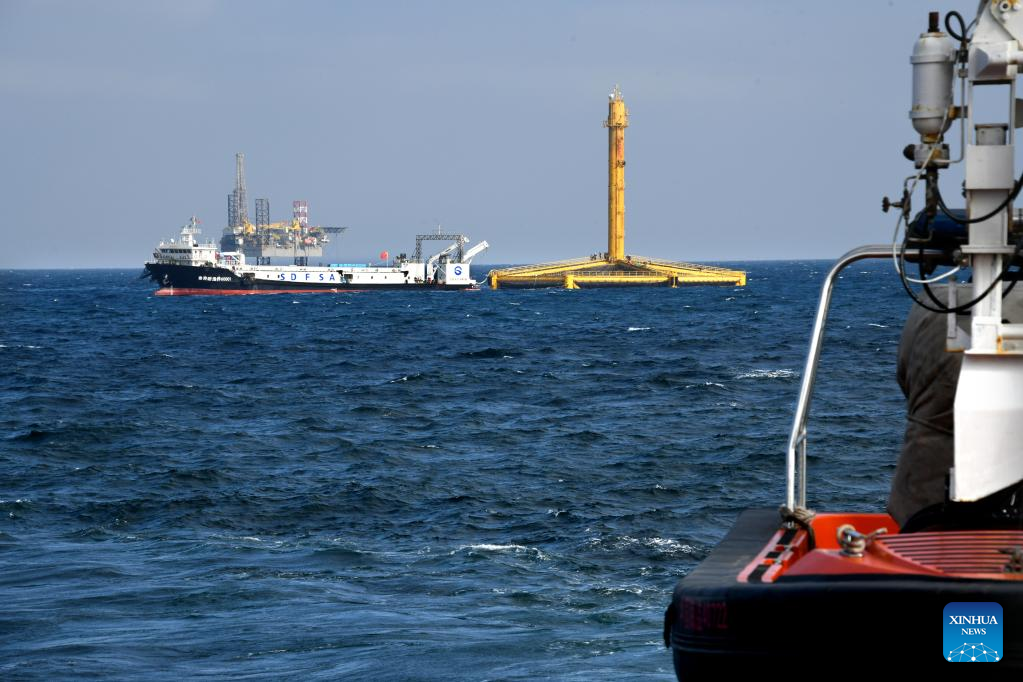
A salmon processing vessel harvests Atlantic salmons near the "Deep Blue No. 1" at a fish farming experimental area of Qingdao, east China's Shandong Province, June 7, 2022. "Deep Blue No. 1," located at about 130 nautical miles from the coast of the Yellow Sea of China, is the first fully submersible deep-sea fish farming equipment built by China.
About 15,000 Atlantic salmons in the net cage of the fully submersible deep-sea fish farming equipment were fished during the period from May 22 to June 9, which marks China's first successful harvest of self-bred deep-sea Atlantic salmons.
(Xinhua/Li Ziheng)

Staff members arrange the harvested Atlantic salmons on a salmon processing vessel at a fish farming experimental area of Qingdao, east China's Shandong Province, June 8, 2022. "Deep Blue No. 1," located at about 130 nautical miles from the coast of the Yellow Sea of China, is the first fully submersible deep-sea fish farming equipment built by China.
About 15,000 Atlantic salmons in the net cage of the fully submersible deep-sea fish farming equipment were fished during the period from May 22 to June 9, which marks China's first successful harvest of self-bred deep-sea Atlantic salmons.
(Photo by Yu Fangping/Xinhua)
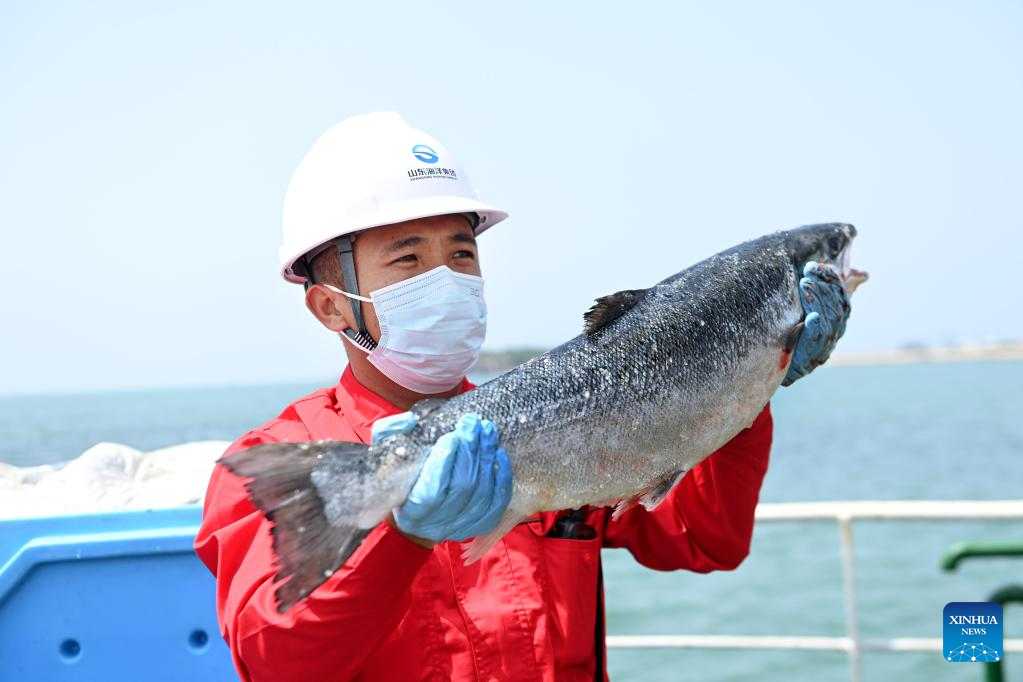
A staff member shows a harvested Atlantic salmon on a salmon processing vessel at a fish farming experimental area of Qingdao, east China's Shandong Province, June 8, 2022. "Deep Blue No. 1," located at about 130 nautical miles from the coast of the Yellow Sea of China, is the first fully submersible deep-sea fish farming equipment built by China.
About 15,000 Atlantic salmons in the net cage of the fully submersible deep-sea fish farming equipment were fished during the period from May 22 to June 9, which marks China's first successful harvest of self-bred deep-sea Atlantic salmons.
(Photo by Yu Fangping/Xinhua)
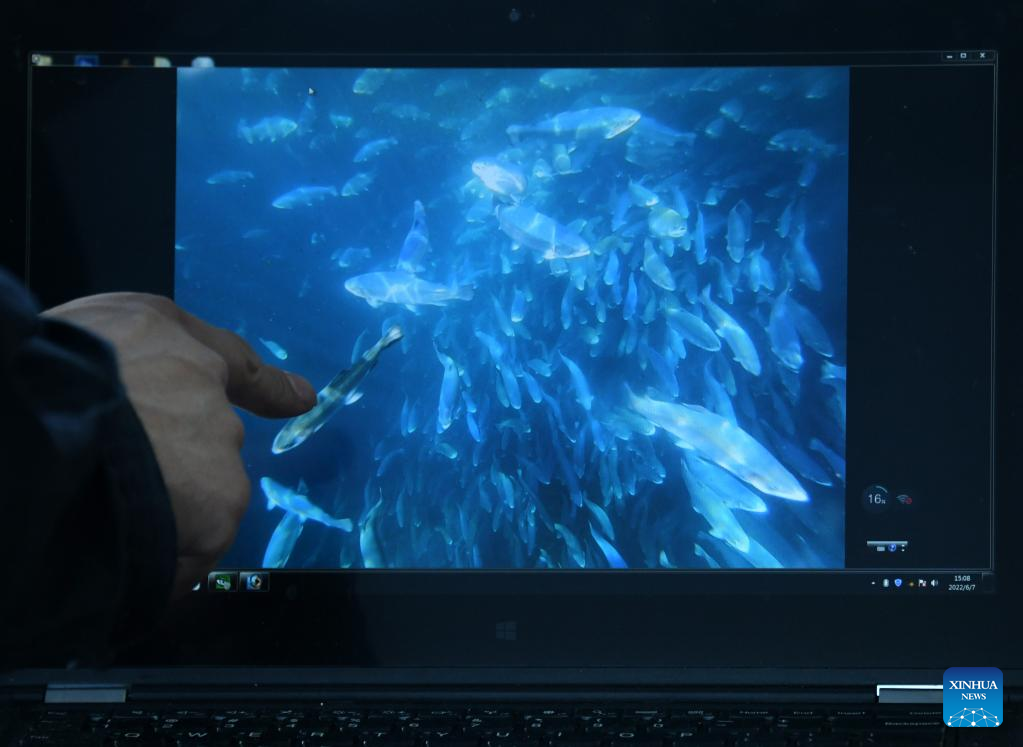
A staff member shows the image of Atlantic salmons in the net cage of "Deep Blue No. 1," June 7, 2022. "Deep Blue No. 1," located at about 130 nautical miles from the coast of the Yellow Sea of China, is the first fully submersible deep-sea fish farming equipment built by China.
About 15,000 Atlantic salmons in the net cage of the fully submersible deep-sea fish farming equipment were fished during the period from May 22 to June 9, which marks China's first successful harvest of self-bred deep-sea Atlantic salmons.
(Xinhua/Li Ziheng)
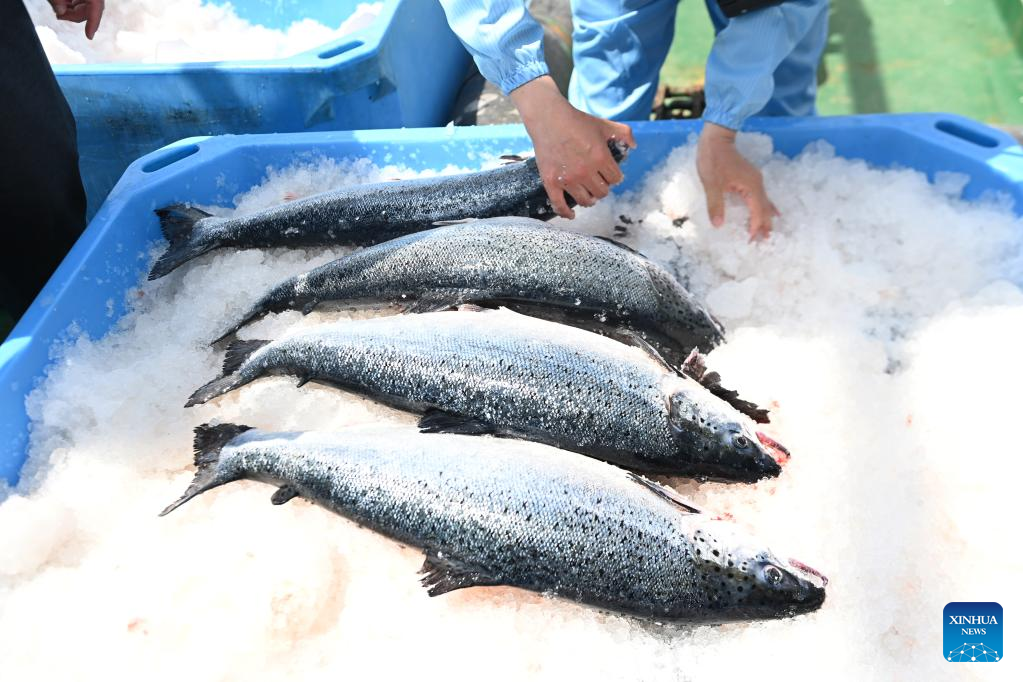
A staff member arranges harvested Atlantic salmons on a salmon processing vessel at a fish farming experimental area of Qingdao, east China's Shandong Province, June 8, 2022. "Deep Blue No. 1," located at about 130 nautical miles from the coast of the Yellow Sea of China, is the first fully submersible deep-sea fish farming equipment built by China.
About 15,000 Atlantic salmons in the net cage of the fully submersible deep-sea fish farming equipment were fished during the period from May 22 to June 9, which marks China's first successful harvest of self-bred deep-sea Atlantic salmons.
(Photo by Yu Fangping/Xinhua)



